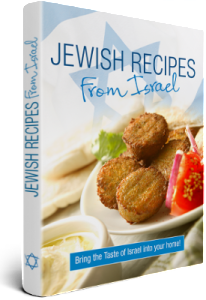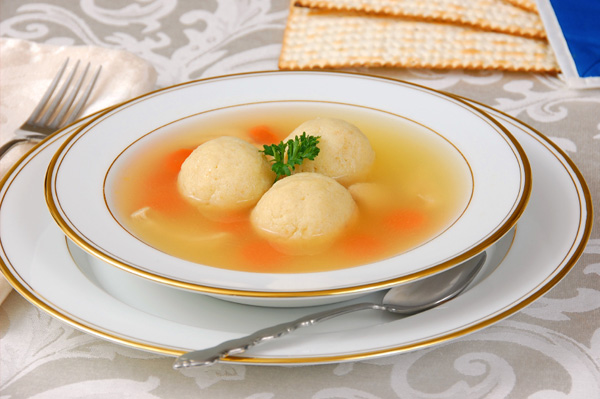
By Rabbi Ari Enkin, rabbinic director, United with Israel
In the second article in the Jewish Food Series, we looked at popular Jewish appetizers, especially those served on Shabbat, along with the traditional Shabbat bread. In this third and final installment we will discuss the classic Shabbat soup and Shabbat day main course, along with some popular side dishes.
Soups
A number of soups are characteristically Ashkenazi (Jews of eastern European origin), one of the most common of which is chicken soup, traditionally served on Shabbat, holidays and special occasions. The soup may be served with noodles (lokshen in Yiddish) or rice. It is also often served with croutons, which are very popular in Israel, called shkedei marak (Hebrew for “soup almond) in Hebrew and mandlen or mandlach in Yiddish. Other popular additions include kreplach and kneidelach – a mixture of matzo meal, eggs, water, melted fat, pepper and salt. Some reserve kneidlach and kreplach for Passover and other special occasions.
Soups such as borscht were considered a staple in the Ukraine. Soups like krupnik were made of oatmeal, potatoes and fat. This was the staple food of the poor students of the yeshivot. Wealthier families added meat to the soup. At weddings, “golden” chicken soup was often served. The reason for its name is probably the yellow circles of molten chicken fat floating on its surface. Today, chicken soup is widely referred to (not just among Jews) as “Jewish penicillin” and hailed as a cure for the common cold.
Carrot Tzimmes
Tzimmes is a traditional Ashkenazi Jewish sweet stew typically made from carrots and dried fruits such as prunes or raisins, often combined with other root vegetables. Some add chunks of meat (usually flanken or brisket). The dish is cooked slowly over low heat and flavored with honey or sugar and sometimes cinnamon or other spices. The name may come from the Yiddish words tzim (for) and esn (eating).
Tzimmes is often part of the Rosh Hashana meal, when it is traditional to eat sweet, honey-flavored dishes. Traditionally sliced in rounds, carrots bring to mind gold coins, symbolizing the hope of prosperity in the year to come. Turnips were also used for tzimmes, particularly in Lithuania. In southern Russia, Galicia, and Romania, tzimmes was made of pears, apples, figs, prunes or plums.
“To make a big tzimmes over something” is a “Yinglish” expression that means “to make a big fuss.” The expression is probably an extension of all the work, such as the slicing, mixing, and stirring that go into the preparation of the dish.
Cholent
Cholent is the traditional Jewish stew. It is usually simmered overnight for 12 hours or more and eaten for lunch on Shabbat.
Cholent was developed over the centuries in conformance with Jewish law, which prohibits cooking on the Sabbath. As such, the pot is brought to boil on Friday before the Sabbath begins and kept on a hotplate, or placed in a slow cooker until the following day.
There are many variations of the dish that are standard in both Ashkenazi and Sephardi kitchens. The basic ingredients of cholent are meat, potatoes, beans and barley. Sephardi-style cholent, known as hamin, uses rice instead of beans and barley, and chicken instead of beef. A traditional Sephardi addition is whole eggs in the shell which turn brown overnight. Ashkenazi cholent often contains kishke (Jewish stuffing) or helzel (a chicken neck skin stuffed with a flour-based mixture). Slow overnight cooking allows the flavors of the various ingredients to permeate the dish, resulting in the unique, characteristic taste of cholent.
Scholars believe that the word “cholent” is related to the Latin calentem, meaning “that which is hot.” Other suggest that the word has its origins in the French words chaud (hot) and lent (slow). In traditional Jewish families, both Ashkenazi and Sephardi, cholent or hamin is the main course of the midday Shabbat meal served on Saturdays after the morning synagogue services.
Kugel is another Shabbat favorite, particularly lokshen kugel, a sweet noodle pudding, often with raisins and spices. Non-sweet kugels may be made of potatoes, carrots or a combination of vegetables.
Kugel
The name of the dish comes from the German kugel, meaning sphere, globe or ball; thus the Yiddish name likely originated as a reference to the round, puffed up shape of the original dishes. Nowadays, however, kugels are usually baked in square pans.
Savory kugel may be based on potatoes, matzah, cabbage, carrots, zucchini, spinach or cheese.
The first kugels were made from bread and flour and were savory rather than sweet. Approximately 800 years ago, cooks in Germany replaced bread mixtures with noodles or farfel (Yiddish for egg noodles). In Poland, Jewish homemakers added raisins, cinnamon and sweet curd cheese to noodle kugel recipes. In the late 19th century, Jerusalemites combined caramelized sugar and black pepper in a noodle kugel known as Yerushalmi kugel, or Jerusalem kugel, which is commonly served at a kiddush (informal gathering after reciting the Kiddush – prayer sanctifying the Shabbat or Festival, after which people partake of food and drink) and as a popular side dish with cholent during Shabbat lunch.
Click below to read Parts 1 and 2 of this series.
https://unitedwithisrael.org/an-introduction-to-jewish-cuisine-and-traditional-shabbat-foods/
https://unitedwithisrael.org/jewish-cuisine-part-ii-tantalizing-appetizers/

Free Ebook: Jewish Recipes from Israel
Jewish food has developed over thousands of years, influenced by the diverse cultures and cooking from Jewish communities around the globe. As more and more Jews return to their Jewish homeland in Israel, new and exciting twists to traditional Jewish food come with them.
Get the best collection of Jewish recipes from Israel in this free exclusive Ebook from United with Israel.
